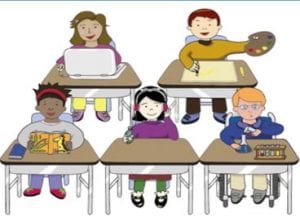
Businesswoman holding earth front of blackboard
The desire for an educated populous began in America before the nation was officially born. As an American colony, Boston Massachusetts would be the first to offer a publicly supported school. In 1635 The Boston Latin School was opened with the primary objective of college preparation for young boys.
In 1647 the Massachusetts Bay Colony General Court made declarations for public schools throughout the colony for the primary purpose of ensuring Puritan children could read the bible as well as educating virtues of family, religion, and community.
Over the last 383 years, education has evolved from the desire for religious literacy to a public system designed to educate the masses in a variety of subjects and for a variety of purposes. However, the core of a social studies education has ebbed and flowed with the needs of the nation.
From a discipline crafted to ensure a fledgling nation survived to a discipline sharpened to create nationalism in a nation torn apart by civil war, social studies has refined its discipline to practice evaluation, analysis, and application of contemporary conditions that shape not just the nation but the world.
As society becomes more complex, the need to integrate multiple perspectives, from multiple fields is necessary. In keeping with the complexity of society, social studies as a discipline will too become more complex. Since no single subject can provide an answer to the multifaceted issues facing a 21stcentury populous, social studies offer a holistic way to prepare students to view societal issues from an informed viewpoint.
A unique value found in an informed viewpoint is in the practice of historical empathy. Social studies provides the ability to clarify personal beliefs and assertions, and become a learned decision maker in not only matters of democracy but in matters of a democratic world. Social studies offers the unique perspective and essential responsibility of thinking in terms of the human experience. The discipline of social studies will continue to evolve in step with the nation as We The People continue to unpack what it means to be a civic-minded citizen, a steward of the nation, and a student of human experience. After all, the study of social studies is the study of being human.
And students like the study of being human. When surveyed, students are in favor of a social studies education and students see far-reaching benefits of a social studies education. Benefits which extend past the content area and surface in transferable skills and abilities; such as the ability to form and support opinions, evaluate concepts and ideas, develop critical thinking skills, strengthen reading comprehension, and unearth the true role(s) of an American citizen. However, without social studies, without examining the world through the lens of evidence-based discovery, a student ultimately begins to believe a Google search result is bond.
I can think of no subject area taught which does not have its roots in the broad foundation of the social studies discipline. To have a social studies education is to have a holistic human education cemented into the skill set(s) most desired in the workplace. Success is not measured in singularity, and I can think of no better multidisciplinary education to give to a student than a social studies education.
The promotion of civic aptitude and the installation of socially acceptable values as core features of social studies was vital to the experimental Republic in creating an active citizenry and has remained vital to continue that strong citizenry.
 In my last post Reflections on Classroom Management: Emotional Consistency and Classroom Management – Part I, I reflected on the disruptive behavior in Ms. S’s class and how a self-inventory regarding emotional consistency may be helpful to Ms. S in turning around the classroom culture.
In my last post Reflections on Classroom Management: Emotional Consistency and Classroom Management – Part I, I reflected on the disruptive behavior in Ms. S’s class and how a self-inventory regarding emotional consistency may be helpful to Ms. S in turning around the classroom culture.
In this second post Reflections on Classroom Management: Refusal in the Classroom – Part II, I reflect on the practice of meeting student’s where they are and understanding refusal.
I begin every reflection concerning behavior with the same question “What is this student trying to communicate through this behavior?” I believe all behavior is a form of communication and decoding the communication of behavior is important.
The second scenario I reflected on concerned Mr. P. and his story about “refusal.”
Mr. P is a physical education teacher and he is concerned about five students in one of his physical education class who refuse to dress out. Despite several consequences:
- Taking points away from their averages,
- Contacting parents,
- Sending them to a study hall classroom instead of gym class; and,
- Having the “refusal” students ‘run laps’ in their regular school dress.
the students continue not dressing out. While the majority of the students are participating appropriately, these five “refusers” remain on the sidelines of the activity teasing and tormenting each other as well as others.
When groups of students refuse to follow directions provided by the teacher it can be distressing. Somewhere between an entire class and a single student, there are the small groups of students who, when band together, create an undeniable disruption in the learning environment. When the entire class is not at issue, strategies to effectively manage disruptive behavior may need to be broken down.
To change the behavior and culture of the disruptive five “refusers,” Mr. P may take certain steps, such as:
- Explaining to the five “refusers” exactly what is expected of them when they are asked to dress out,
- Work on building positive relationships with the refusal group as a whole and perhaps the most influential student of the refusal group
- Work on building positive relationships with individual members of the refusal group,
- Provide the five “refusers” with a choice of activity for gym to promote gym buy-in and encourage them to dress out for something they want to do versus something they have to do,
- Verbalize consequences for behaviors which are not appropriate to force the students to share responsibility among themselves for “refusal” behaviors; and,
- Specifically reinforcing the progress and effort individually for each of the five “refusers” as well as the five “refusers” as a group will help cement a successful behavior and attitude change.
Mr. P may also benefit by proving these particular students with a challenge. Providing a challenge or healthy competition for these five “refusers”, may entice these students to participate through the innate drive of competition.
While this strategy is similar to allowing the students to choose their own activities, healthy competition creates an activity not only for the five “refusers” but for the rest of the students as well — possibly creating whole class gym buy-in. Whether these five “refusers” compete against each other or the whole class, creating something that is different from the usual gym class will allow the five “refusers” to channel the negative energy of refusal positively.
 I recently reflected on the practice of setting and maintaining high behavioral expectations in the classroom. I spent some time reflecting on these concepts through the specific lens of producing responsible behavior in the classroom.
I recently reflected on the practice of setting and maintaining high behavioral expectations in the classroom. I spent some time reflecting on these concepts through the specific lens of producing responsible behavior in the classroom.
This reflection was prompted after listening in on a few conversations being had by veteran teachers. After listening to several conversations I began to reflect on my approach to handling those behaviors now that I have more than an academic understanding of classroom management.
I seem to begin every reflection concerning behavior with the same question “What is this student trying to communicate through this behavior?” I believe all behavior is a form of communication and decoding the communication of behavior is important. Students are crafty, and they know how to get, or get out of, something by ‘behaving’ in a certain manner (the function of behavior).
The first scenario I reflected on encompassed a classroom narrative by “Ms. S”.
Ms. S has an extremely disruptive class and she is both frustrated and concerned about the students’ classroom behavior. Ms. S has employed a rewards system and tried to follow through with consequences for bad behavior, but the students are still disruptive. Ms. S often becomes so frustrated with the student’s behavior that she admits to sometimes ‘losing her cool’ by yelling at the students. Ms. S has even gone so far as to drop a book on the floor because she thought the loud noise would get the students attention.
Disruptive behavior in Ms. S’s classroom looks like the student’s:
- Calling out
- Leaving their seats,
- Talking with other students during instructional time
- Making inappropriate comments both to the teacher and to other students
- Not following directions
Ms. S has tried such consequences as:
- Writing students’ names on the board for talking after several warnings,
- Threatening to contact parents for disruptive behavior,
- Threatening to ‘write-up’ students for not following directions,
- Detention for students throwing objects or not complying with instruction; and,
- The removal of a student’s desk from the class for making faces and causing other students to laugh.
Ms. S has even gone so far as to hold students after the dismissal bell because she had not verbally dismissed the class and when the students began to leave regardless of her verbal commands to remain seated, she physically blocked the student’s egress.
Disruptive behavior can adversely affect the classroom environment and negatively affect the learning experience of students. Although it is ideal to prevent disruptive behavior before it begins, there are times when active measures must be taken once disobedience has become classroom culture.
Since Ms. S’s classroom exhibits almost every disruptive behavior imaginable and from all students, it can easily be assumed that Ms. S is frustrated, tired, and discouraged regarding her student’s classroom behavior—it can also be easily assumed that her students know this.
To change this classroom culture, Ms. S’s first action needs to be an evaluation of herself. Taking inventory of your own emotional consistency as a teacher is important. When a teacher consistently manages his or her emotions it encourages student learning and achievement by creating a safe environment of calm and learning. Since teachers are the leaders of classroom culture, the teacher’s emotions dictate classroom culture.
There are several strategies to help a teacher maintain emotional consistency in the classroom:
- Walk slowly towards the problem situation to give a moment or two to regain composure before addressing the problem,
- Ensure that the words used in a problem situation condemn the behavior, not people,
- Make sure to take the relationship out of any corrective action;
- Be conscious and cautious of tone and non-verbal signals; and,
- Avoid globalizing the problem situation or behavior.
It is important to avoid showing the students that their behaviors have flustered the teacher in any way. While easier said than done, when a close read of one’s own behavior is done, the results can inspire meaningful behavior change for the individual as well as meaningful classroom cultural change.
 Promoting a learning environment steeped in respect, scholarship, and accountability requires the classroom to possess a certain cultural competence. Like with all competencies, students arrive to the classroom at different places. Just as we differentiate for content, we too must differentiate for cultural competence with the goal of getting students on the same page.
Promoting a learning environment steeped in respect, scholarship, and accountability requires the classroom to possess a certain cultural competence. Like with all competencies, students arrive to the classroom at different places. Just as we differentiate for content, we too must differentiate for cultural competence with the goal of getting students on the same page.
This is especially important as secondary school focuses more on collaborative learning as an instructional method. Collaborative learning activities require students to have an open mind, a healthy respect for others who hold both similar and opposing opinions, as well as for students to feel safe enough to express thoughts, viewpoints, beliefs, and ideas in the classroom.
However, what happens when the collaborative group has different opinions? Often conflict erupts and needs to be quelled. While conflict management and conflict resolution are often used interchangeably, they are not the same thing. Conflict management generally refers to an individual’s conflict “style” or their reaction to conflict while conflict resolution utilizes the skills employed to resolve a conflict.
I mention this distinction because when classroom disagreements between students arise, the student behaviors are typically conflict management behaviors and the teacher behaviors are typically conflict resolution behaviors. Understanding this concept as a teacher allows you to help your students learn to operate in an environment of productive — respectful disagreement.
I assure you from personal experience, as someone who use to do mediation work for the EEOC in Atlanta, that respectful disagreement is rare. It is so critical to teach students to agree to disagree, focus on the problem, not the person, and not to personalize uncomfortable feelings. It is easy to get caught up in disagreements over values, judgments, and beliefs; especially ones held close. It is vital to teach young people how to navigate those disagreements, and sometimes the cognitive dissonance that goes along with disagreements over such personal issues, with mutual respect.
In the end, conflict is merely the inability to communicate effectively, tolerate differences of opinion, and a strong penchant for personalizing the problem – making the person the target of the conflict, not the problem. These deficits create intractable positions and an “us” versus “them” mentality, making conflict resolution virtually impossible.
This is why I believe that fostering communication, a safe space for disagreement, and a culture of openness and tolerance in the classroom is so important. If students learn to manage their emotions in the face of differing opinions as well as learn to pay attention to the feelings (not just the words spoken) of the other person, they will be much more able to manage conflict stress, while remaining calm and moving towards amicable solutions to problems; even if the solution is agree to disagree. If students are taught these skills early, they will most certainly carry this skill set into their adult lives, and perhaps there will be fewer cases to settle at the EEOC.
 Humans are unique creatures. The advancement of society from the nomadic tribes of yesteryear to today’s technically connected epicenters has depended mainly on human’s ingenuity. How did humans learn to be so creative, resourceful, and knowledgeable? Was it through a well thought out academic framework? Was it trial by fire? Or a combination of numerous influences all as unique as the individuals themselves?
Humans are unique creatures. The advancement of society from the nomadic tribes of yesteryear to today’s technically connected epicenters has depended mainly on human’s ingenuity. How did humans learn to be so creative, resourceful, and knowledgeable? Was it through a well thought out academic framework? Was it trial by fire? Or a combination of numerous influences all as unique as the individuals themselves?
A plentiful cache of learning theories has attempted to answer those questions, and it is safe to say that no sloe theory tells us exactly how humans learn. However, several have been well researched, thoroughly documented, and soundly applied providing confidence in the broad elements.
Varied instruction takes into consideration the theories of multiple intelligence, constructivism, humanistic psychology, and cognitive development through the idea of neurodiversity. Boiled down to its most basic points, neurodiversity creates a complex educational landscape, one in which the educator attempts to navigate through more individualized instruction.
Individual difference variables are the drivers of a classroom of varied instruction. Honing in on those elements which make each learner unique and creating a curriculum which caters to those individual learning differences is a tall order. In an education system which is designed to education enmass, it may seem that the ‘teach to the average’ method which was employed for an industrialized America is now the system with which we are stuck. This is not the case. Although it seems impossible for mass education to accommodate one-on-one individualized education, detailed planning and first-hand knowledge of students makes the impossible into the possible.
In a diverse learning environment where each learner’s strengths and weaknesses are known, measured, supplemented, and assisted; the individual learner has a chance. With the theory of varied instruction in mind, reviewing cognitive processes, how the brain learns, how the developing brain is posited to learn multiple things, in multiple ways, at multiple times, is the key to successful, motivated, autonomous learners. Bottom line, providing ‘voice and choice’ to accomplish the same goal (write an essay, create a mind map, drawn a comic strip) will accomplish the same objectives.
What does varied instruction look like in your classroom?
 Last night after a meal with friends, we stood on the sidewalk in small lingering conversation before heading to our cars. We were talking about substitute teaching and how it was difficult to find substitutes for certain subjects. Then a comment was made to me “Are you OK substituting for a class other than social studies?” I immediately replied, “Yes!” because it never occurred to me that I wouldn’t be, I mean, I have so much more experience than my endorsement areas.
Last night after a meal with friends, we stood on the sidewalk in small lingering conversation before heading to our cars. We were talking about substitute teaching and how it was difficult to find substitutes for certain subjects. Then a comment was made to me “Are you OK substituting for a class other than social studies?” I immediately replied, “Yes!” because it never occurred to me that I wouldn’t be, I mean, I have so much more experience than my endorsement areas.
This was the second such conversation in as many days. These lingering conversations have stuck with me, and I was left with a heavy thought – people don’t know me. In this world of “What do you do for a living?” the answer is typically singular, I’ve said, “I’m a paralegal.” Everyone moves on. This answer is not just a categorizer but an identity definer– and it shouldn’t be.
I have a rich and varied background, one people know little about. I’ve come to realize, not only is “paralegal” not what I do anymore, and haven’t for a while, but I’ve also done so much more. From that first job in a restaurant to “I’m a paralegal making the career switch into the field of education” I’ve gained career and life experience unknown to others.
I’ve worked in a variety of industries such as landscaping, retail, hospitality, banking, security (certified), legal (4 practice areas), management consulting, human resources (certified), and mediation (Master’s trained).
I’ve worked for large, medium, and small private and commercial business, start-ups, law firms, government agencies, and higher education. I’ve worked on a sales floor, in a cube, in an office with a door and virtually. As an intern, I’ve even worked in a hallway sitting in a folding metal chair. I’ve trained on so many software systems; I couldn’t name them all if I tried.
I have 155 undergraduate credits sitting beside over 50 graduate credits all accompanied by a manila folder 1/3 of an inch thick with certifications, workshops, and seminar attendance certificates. I clocked practitioner level training in areas such as social and emotional learning, behavioral support, special education, neuropsychology, nutrition and wellness, and spent countless research hours and written untold many unpublished papers on humanities topics from A to Z.
I definitely have multiple layers, transferable skills and competencies, and a rich background that surprises many; if and when they ever learn of it. Perhaps I should do a better job of “marketing” myself, but my attempts have been met with skepticism and doubt – that one person could have so many accomplishments, yet never in a discrete area. It’s true, my life is mapped in pencil, and the journey is a winding road filled with adventure but if one looks closely, my life’s concentration revolves around humanities and education.
My curiosity always drives me to learn more, to discover, to ferret out information. Fascination is my calling, surface level knowledge isn’t an option for me – I need to satisfy the perpetual need to learn – to soak up information, experiences, and people.
Out of everything I’ve done, this…, this curiosity is why I feel I’m being called to the classroom. The classroom allows me to take all of ‘me’ and give it over to my students. It allows me to take this eclectic life and give it over to fresh minds, for them to cherry pick things that fit. It also allows me to learn everything I can from them and together make this community better. Because in the end, learning is supposed to be an exciting – eclectic human experience.

Globalization is not a new concept; in fact, modern industrialization can be marked by 19th-century advancements in automation. The ability to mass produce items created a global trade market which opened up new economies. The 20th century ushered in more than trading goods between different countries—it offered a glimpse into commercial integration. With the advent of the internet in 1990 advancements in technology have created an interconnected 21st-century world (1). From globalized business to connection through social media, technology has taken an insulated population and created a global population.
This is especially apparent when we look at our classrooms. Students have a constant online presence, interacting with people from around the world on a daily basis. As educators, we have an opportunity to harness a student’s interest in other people and a student’s curiosity about other cultures to create cultural competence for success in the ever complex 21st-century world. Further, as educators we are guided by the United States Department of Education’s (ED) “mission to promote student achievement and preparation for global competitiveness by fostering educational excellence and ensuring equal access” (2) and encouraged by the United Nations Sustainable Development Goals to educate students about “the global challenges we face, including those related to poverty, inequality, climate, environmental degradation, prosperity, and peace and justice” (3). Although the purpose is clear, the “why” is sometimes opaque.
So why do our students need global competence? Twenty-first-century students exist in a diverse and interconnected world. Mass migration erases borders, concerns over climate instability create community, and constant social and technological interconnection amalgamates cultures. This means students must learn global competence to discover ways to live harmoniously in multicultural communities, thrive in a changing labor market, and use media platforms effectively and responsibly. Teaching students to investigate worlds beyond their immediate environment promotes cultural awareness and respectful community interactions as well as affords respectful communication with diverse audiences (4).
This integrative outlook on the world is not just a collection of independent skills; it is both a disciplinary and interdisciplinary understanding of the globe as a system (4). This interdisciplinary understanding needs to be purposeful, grounded, interactive, and thoughtful (4) to keep students engaged in the learning process. Student engagement is key in any learning process but is especially important when students are tackling concepts outside of their comfort zones. Collaborative learning, and working through the lens of empathy, can help students absorb the dissonance in these topics.
Zepke & Leach, 2010 note that “When institutions provide opportunities for students to learn both autonomously and with others, and to develop their sense of competence, students are more likely to be motivated, to engage and succeed.” (5). Educators can have students work independently and together to create a habit of global competence by asking students to complete such assignments as “write an argument concerning the promise and period of globalization, or a narrative on life of a migrant child, or an explanation of how communication technologies work to facilitate democratic movements in a given region” (4). Asking the students to engage in discussions about complex problems and work collaboratively to find solutions helps them stay on task by tapping into the emotion which drives cognition (Schwatrz, 2016); these are critical metacognitive skills needed to internalize concepts of a globalized system.
The future is here, globalization is real, and 21st-century students need competencies in order to work with people from different cultures, on global teams, and with international consumers. Students need to envision, tackle, and solve problems in ways not yet conceived, and of course the competition in the global business arena is only becoming more competitive. By engaging students through addressing global challenges, globalizing the context for learning, connecting universal themes, illuminating global knowledge and history, and learning through international collaboration (4), we can ensure that our students are ready for the future that lies ahead.
 Reading and writing are core competencies in not only every single academic subject but in every workplace. In today’s complex, information, and data-driven society, the need to read content and write as a form of expression is even more critical. Unfortunately, as the need for these basic skills increase, the ability of our secondary students to competently perform said tasks decreases. As workplace texts become more complex, the texts with which we train our future generations in both primary and secondary schools become easier. In fact, “employers rank reading and writing as top deficiency’s in new hires” (1). Moreover, a sizeable sum is spent by employers in the remediation effort to ensure new hires are proficient in basic reading and writing skills.
Reading and writing are core competencies in not only every single academic subject but in every workplace. In today’s complex, information, and data-driven society, the need to read content and write as a form of expression is even more critical. Unfortunately, as the need for these basic skills increase, the ability of our secondary students to competently perform said tasks decreases. As workplace texts become more complex, the texts with which we train our future generations in both primary and secondary schools become easier. In fact, “employers rank reading and writing as top deficiency’s in new hires” (1). Moreover, a sizeable sum is spent by employers in the remediation effort to ensure new hires are proficient in basic reading and writing skills.
Why are secondary students graduating from high school without basic competencies in reading and writing? The reasons are as plentiful as the student’s individual differences; however, one universal strategy to remedy the deficiencies is to teach both reading and writing in each classroom as both a method of instruction and intellectual activity (2).
For reading, incorporating multiple literacies into the classroom helps students learn to mentally organize information and learn key vocabulary. Teaching writing can pose more challenges for educators than teaching reading, simply because writing is a time-consuming craft. However, there are five guiding principles regarding writing instruction (2):
- Teacher: The teacher is the facilitator of the process and an expert in the content
- Time: Time must be made for writing. Because writing is a process of drafting and re-drafting, there must be ample time dedicated to the task of writing.
- Technology: Technology can be used to help students in the writing process. Software such as Microsoft Word and Google Classroom can change the entire landscape of writing for countless students.
- Assessment: Measure student growth in writing. Although this is a difficult and somewhat subjective task, the assessment of growth in writing is critical to helping students find strategies to make them better writers.
- Practical Strategies: Implementing strategies such as pre-writing, drafting, revising, and editing assists the student in the “how” of writing
Once students learn that sitting down and writing a paper for submission in one sitting is virtually impossible (unless that is what the assignment calls for), then they will learn that part of the process of writing is patience and part of the process is reflection. These guiding principles of teaching writing improve student learning.
In short, a teacher preparation program requires a course in reading and writing in the content area for each classroom because students cannot be college ready, workplace-ready, or world ready if they cannot read and write. Effective writing is vital for the classroom, and the workplace (2). Once students are fluent readers, they often read for pleasure, and this correlates strongly with academic achievement (1), translating into higher salaries and more job satisfaction in adulthood. It is the responsibility and the opportunity of each educator from each discipline to equip students with the tools they need.

Body language is a large part of how humans communicate their wants, needs, and desires with each other. Body language can invite us into a conversation or isolate us from groups. It is a silent barometer of socialization and can affect an emotional state of being – vacillating from the positive to the negative. In the end, the interpretation of body language is up to the individual perceiving, the feedback receiver, and a host of individual differences which drive how the signal is decoded. A sigh from the teacher may be humorous to one student, anger-inducing to another, and sorrowful to yet another. This student perception of a teacher’s silent language can impact student performance and self-esteem.
In a 2009 book chapter by Eccles and Roeser, they discuss schools and academic motivation through various levels. The one thing all of the levels have in common is teacher influence. Suffice to say; teachers have a great deal of influence in and on the lives of their students. Although the authors do not explicitly discuss body language, gestures, and non-verbal cues, they make huge statements regarding teacher influence in the classroom. How a student perceives a teacher feels about him/her can have a remarkable impact in the classroom.
The point? If teachers have such a strong influence over the outcomes of their students in the classroom through presumably straightforward indications of praise or condemnation, imagine what happens in the complex, mixed-message, broken feedback loop involved in the silent language of the body. This is something all people need to be mindful of, especially teachers.
Being mindful of how one handles the unexpected is also essential. I think everyone handles the unexpected differently but staying calm, steady, and even-toned is a must. Emotional reactivity encourages, and sometimes, creates more emotional reactivity. For example, if a disruptive student interrupts for the third time in five minutes, a teacher may respond in an angry tone, make a disapproving facial expression, or send other non-verbal signals of annoyance, creating a feeding emotional cycle where the student ‘returns’ those emotion(s) back to the teacher, the teacher to the student, and before anyone realizes, there are heightened feelings and chaos. In contrast, there may be a child who fails to recognize and decode the teacher’s body language when a signal is meant to be sent; this is not typical and can be unexpected. When a student fails to read the nuances of the silent language they may not realize that the teacher is not approving of their actions and they will continue to engage unless explicitly told verbally to stop. Lastly, remember to focus on the problem, not the person, because disruptive behavior and unexpected student issues usually occur from places which are emotionally or cognitively outside of their control.
In the end, body language is always working; it speaks more often and can be interpreted in variation more than verbal language, and we need to be cognizant of the messages we send. I am an expressive person and perfecting a veil for my own silent language will be a skill to perfect.

The journey to answering the question “What do you want to be when you grow up?” is no longer as straightforward as it may have been in years past. Rapid and ever-evolving technological advances change the landscape of the educational and workplace environments at a dizzying pace.
Millions of American children are not engaged, attaining, or thriving in secondary educational institutions. Regardless of how one discretely defines these attributes, holistically speaking, adolescents of today are largely unprepared for adulthood. Specifically, these adolescents are not ready, upon graduation, to attend any institution of higher learning or secure meaningful employment. In short, they are not College and Career Ready.
Preparing youth for today’s competitive environment falls mainly at the feet of the secondary educational system(1). However, with an overwhelming 44.8% of high school juniors and seniors not feeling positive about their college and career readiness (2) it is clear that secondary educational institutions need to take steps, in tandem with parents, to help them prepare. Generally, college and career readiness can be defined as the:
“level of preparation a student needs in order to enroll and succeed, without remediation, in a credit-bearing course at a postsecondary institution that offers a baccalaureate degree or transfer to a baccalaureate program, or in a high-quality certificate program that enables students to enter a career pathway with potential future advancement” (3).
Read this definition to any person on the street and ask if they think the youth of today meet these criteria, and, from the research, the answer would likely be “no.” That chance increases as you ask parents, teachers, college professors, and employers.
Since successful participation in the college classroom and workforce requires both formal education and hands-on experience to be college-ready, it necessitates that the secondary educational system is responsible for best preparing the students while they are still in school. Virginia schools are ready for this challenge, through various programs such as internships, externships, and Career and Technical Education (CTE) programs as well as the integration of career exploration as part of the foundational curriculum.
Career exploration is longer be thought of as an elective to be taken as a “time filler” on the student’s schedule. Virginia is creating a meaningful and streamlined progression for career exploration, not a course that provides a list and says “go learn about this on your own.” Virginia also utilizes the Advance CTE: State Leaders Connecting Learning to Work! a program which offers courses under the 16 different career clusters with 70 different career pathway(4).
By incorporating both college and career education training in hard and soft skills, Virginia’s Profile of a Graduate marches in lock-step with the goals of colleges and employers alike, preparing Virginia graduates for success in the 21st century.

 In my last post Reflections on Classroom Management: Emotional Consistency and Classroom Management – Part I, I reflected on the disruptive behavior in Ms. S’s class and how a self-inventory regarding emotional consistency may be helpful to Ms. S in turning around the classroom culture.
In my last post Reflections on Classroom Management: Emotional Consistency and Classroom Management – Part I, I reflected on the disruptive behavior in Ms. S’s class and how a self-inventory regarding emotional consistency may be helpful to Ms. S in turning around the classroom culture. I recently reflected on the practice of setting and maintaining high behavioral expectations in the classroom. I spent some time reflecting on these concepts through the specific lens of producing responsible behavior in the classroom.
I recently reflected on the practice of setting and maintaining high behavioral expectations in the classroom. I spent some time reflecting on these concepts through the specific lens of producing responsible behavior in the classroom. Promoting a learning environment steeped in respect, scholarship, and accountability requires the classroom to possess a certain cultural competence. Like with all competencies, students arrive to the classroom at different places. Just as we differentiate for content, we too must differentiate for cultural competence with the goal of getting students on the same page.
Promoting a learning environment steeped in respect, scholarship, and accountability requires the classroom to possess a certain cultural competence. Like with all competencies, students arrive to the classroom at different places. Just as we differentiate for content, we too must differentiate for cultural competence with the goal of getting students on the same page. Humans are unique creatures. The advancement of society from the nomadic tribes of yesteryear to today’s technically connected epicenters has depended mainly on human’s ingenuity. How did humans learn to be so creative, resourceful, and knowledgeable? Was it through a well thought out academic framework? Was it trial by fire? Or a combination of numerous influences all as unique as the individuals themselves?
Humans are unique creatures. The advancement of society from the nomadic tribes of yesteryear to today’s technically connected epicenters has depended mainly on human’s ingenuity. How did humans learn to be so creative, resourceful, and knowledgeable? Was it through a well thought out academic framework? Was it trial by fire? Or a combination of numerous influences all as unique as the individuals themselves? Last night after a meal with friends, we stood on the sidewalk in small lingering conversation before heading to our cars. We were talking about substitute teaching and how it was difficult to find substitutes for certain subjects. Then a comment was made to me “Are you OK substituting for a class other than social studies?” I immediately replied, “Yes!” because it never occurred to me that I wouldn’t be, I mean, I have so much more experience than my endorsement areas.
Last night after a meal with friends, we stood on the sidewalk in small lingering conversation before heading to our cars. We were talking about substitute teaching and how it was difficult to find substitutes for certain subjects. Then a comment was made to me “Are you OK substituting for a class other than social studies?” I immediately replied, “Yes!” because it never occurred to me that I wouldn’t be, I mean, I have so much more experience than my endorsement areas.
 Reading and writing are core competencies in not only every single academic subject but in every workplace. In today’s complex, information, and data-driven society, the need to read content and write as a form of expression is even more critical. Unfortunately, as the need for these basic skills increase, the ability of our secondary students to competently perform said tasks decreases. As workplace texts become more complex, the texts with which we train our future generations in both primary and secondary schools become easier. In fact, “employers rank reading and writing as top deficiency’s in new hires” (1). Moreover, a sizeable sum is spent by employers in the remediation effort to ensure new hires are proficient in basic reading and writing skills.
Reading and writing are core competencies in not only every single academic subject but in every workplace. In today’s complex, information, and data-driven society, the need to read content and write as a form of expression is even more critical. Unfortunately, as the need for these basic skills increase, the ability of our secondary students to competently perform said tasks decreases. As workplace texts become more complex, the texts with which we train our future generations in both primary and secondary schools become easier. In fact, “employers rank reading and writing as top deficiency’s in new hires” (1). Moreover, a sizeable sum is spent by employers in the remediation effort to ensure new hires are proficient in basic reading and writing skills.
